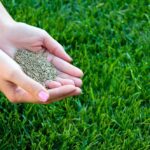Summer is just around the corner. Soon, you’re going to be spending more time outside with your friends and family. Lunch or family barbecues will fill up summer calendars. This season, more than ever, is the perfect time to boast your green and vibrantly healthy lawn.
But how exactly do you prepare your lawn to take on long summer days and rowdy backyard parties?
The following are some tips devised to keep your precious green lawn stunning even with the constant summer wear.
Aeration
Sure, you want a thick mat of grass to cover your entire yard. But when the grass layer gets too thick, it gets harder for water and other essential growth nutrients to penetrate and reach the root zone.

Solve this problem by poking holes on the grass. This will improve air circulation and provide an easy pathway for water and fertilizer to reach the roots where they are needed.
Mow the Grass Properly
Don’t cut your grass too short. Ideally, it’s recommended to cut off only one-third off the top of your grass. This helps ensure that the grass maintains the moisture level required to keep it healthy.
A taller grass system also means there’s an adequate layer of grass thickness to encourages the roots to grow deeper into the soil, providing more grip.
Use a Golf Cart to Do Yard Work
When doing lawn maintenance, it’s sometimes inevitable to keep hauling in materials back and forth, which can wear out certain patches on your grass. Hauling garden carts and wheelbarrows also requires more effort.
Make your job easier by using a reliable golf cart. A golf cart exerts uniform force on your grass, providing proper distribution of the weight. You can use it to hold your materials, easily maneuver around the property, and hold weed in bulk without repeatedly going to and fro through the patches.
Keep Your Mower Blades Sharp
Keeping your mower blades sharp ensures that you neatly cut off the grass. Otherwise, you will just end up tearing the grass, making it easier for moisture to leave the grass blades quickly.
Moisture is key to a green and healthy lawn. So before you mow your lawn, make it a habit to always check the sharpness of your mower blades. Replace them as needed.
Regularly Dethatch
A lawn thatch is a layer of dead turfgrass tissue—commonly composed of grass stems, roots, clippings, and debris that lies between the green vegetation of the grass above and the root system below.
Thatches are usually found in lawn grass that has been left for too long or where much is frequently left. The best defense against thatch buildup is to prevent it in the first place. Take soil pH level tests whenever you can, and apply chemicals where it is necessary to encourage decomposition.
Regular aeration and proper application of fertilizer will also help eliminate thatch problems.
Recycle Your Grass Clippings

After you’ve successfully mowed your lawn, don’t throw away your grass clippings. Instead, let them stay in the lawn. This will help recycle nutrients, safeguard the moisture content, and fertilize it.
Another alternative is to make a tea bag out of your grass clippings. Simply place the clippings in a barrel of water. Allow it to sit for a week and feedback the nutrient-rich concoction back into the lawn.
Take Care of Pet Problems
Your pet’s urine contains acid that can kill off the grass in your lawn, producing unsightly brown patches. While it’s hard to control when and where your favorite pet does his or her business, you can take care of the problem by flushing the unfortunate area with water.
If it’s your kids usually walking the dog, make sure to have them report the incident at once.
Weed Out Crabgrass
Crabgrass is a common homeowner’s headache during spring and summer. This icky, stubborn, invasive weed species is hard to kill. In which case, you may have to resort to using (cautiously) herbicides to kill it off. If you have the time, you can patiently weed it out manually or hire somebody else to do it.
Crabgrass growth is induced by warm temperatures. The best defense to mitigate the problem before it occurs is to fertilize your lawn grass well and maintain a healthy layer of dense grass maintained at a slightly higher height.
Water Properly
Every homeowner must be aware of the dangers of watering the lawn too much or too little. Both can only end up poorly for your yard. Fortunately, you don’t have to babysit your sprinklers and manually monitor the humidity and temperature of the air in order to get your watering level just right.
There are plenty of excellent sprinkler systems today equipped with automatic controllers and other monitoring technologies to water your lawns whenever they need it. Save yourself the trouble, and invest in a good sprinkler system.
Don’t Overfertilize

Before the summer season starts, give your lawn grass the boost it needs for the season once the soil temperature reaches 55°F or approximately 13°C. Fertilize four weeks after and every six to eight weeks in the growing season.
Gradually applying fertilizer will ensure that the nutrients are properly absorbed by the grass and avoid burning caused by rapid fertilizer application.
Conclusion
Active family activities this season will give your lawn quite a beating. See to it that it is properly cared for. Use these tips to keep your home appeal not just in summer but all year round. Diligently integrate these practices into your lawn-care routine to ensure that your lawn stays healthy and beautiful no matter the season.






